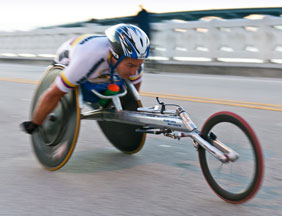Sample Collection Process
An important piece of any anti-doping program is sample collection or the process of securing an athlete’s blood, urine, dried blood spot, and/or other World Anti-Doping Agency (WADA) approved sample, completing documentation, as well as preparing and shipping the sample to a laboratory accredited by WADA. USADA is a signatory to the World Anti-Doping Code (Code), and USADA’s sample collection process is fully compliant with the Code and International Standard for Testing & Investigations (ISTI).
The sample collection process is designed to be a safe process, and as comfortable as possible for athletes, while ensuring that the sample integrity is maintained throughout. The sample collection process is a standard procedure, from notification of the athlete to the shipment of the sample to the laboratory.
Read more about the blood and urine sample collection process using the links below.
Click here to see how the sample collection process has been modified with COVID-19 safety protocols.
Additional Considerations for Impaired Athletes
Due to the sensitive nature of drug testing and the physical requirements for an athlete during sample collection, there are additional considerations for athletes with impairments.

Athlete's Rights
- Having a representative present throughout the doping control process
- Having a language interpreter present, if available
- Completing a training session or other activities while the Doping Control Officer (DCO) or chaperone observes
- Having the testing procedures explained, including how the sample collection equipment works
- Requesting to view the DCO's credentials
- Having a choice of collection vessels and sample collection kits
- Receiving a copy of all forms used to document the processing of your sample
- Providing written feedback on USADA's Athlete Evaluation Form and/or Supplementary Report Form
- Requesting a delay in reporting to the doping control station for valid reasons
- Requesting modifications if you have a disability
Athlete's RESPONSIBILITIES
- Complying with the sample collection procedure**
- Reporting immediately to the doping control station unless there are valid reasons for delay (in-competition testing)
- Bringing a photo ID to the doping control station
- Staying in direct observation of the doping control officer (DCO) or chaperone from the time of notification until the sample collection session is complete
- Keeping the collection vessel and sample in their possession and in view of the DCO at all times
- Having control of the sample until it is sealed in collection bottles (the DCO may assist the athlete)
- Ensuring the sample code number is correctly documented on the doping control official record
- Ensuring all appropriate paperwork is accurate, complete, and signed
**NOTE: As defined by the Code: “Refusing, or failing without compelling justification, to submit to sample collection after notification as authorized in applicable anti-doping rules or otherwise evading sample collection is an anti-doping rule violation.”


